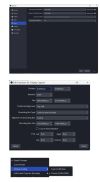Elektraman
New Member
I have a 4K webcam and 3840x2160 displays.
I do tutorials with desktop view and PIP (Picture In Picture i.e me!) which is fuzzy (aliasing issue) on output
Base (Canvas) Resolution - 1920x1080
Output (Scaled) Resolution - 1920x1080
Common FPS Values - 60
I'm trying to resolve the aliasing issue (as it is rather bad). but:
1) Putting a 3840 x 2160 window capture onto a 1920x1080 canvas results in black bars either side
2) Setting BCR to 3840 x 2160 and downscaling to 1920x1080 givs aliasing issues (blurriness in PIP).
I need the sharpest possible picture of the desktop and also my PIP, any advice on how best to acheive this?
(Did think about using Display Fusion to split the monitor into 4 thus giving a virtual monitor of 1920x1080, but is there a better way?)
I do tutorials with desktop view and PIP (Picture In Picture i.e me!) which is fuzzy (aliasing issue) on output
Base (Canvas) Resolution - 1920x1080
Output (Scaled) Resolution - 1920x1080
Common FPS Values - 60
I'm trying to resolve the aliasing issue (as it is rather bad). but:
1) Putting a 3840 x 2160 window capture onto a 1920x1080 canvas results in black bars either side
2) Setting BCR to 3840 x 2160 and downscaling to 1920x1080 givs aliasing issues (blurriness in PIP).
I need the sharpest possible picture of the desktop and also my PIP, any advice on how best to acheive this?
(Did think about using Display Fusion to split the monitor into 4 thus giving a virtual monitor of 1920x1080, but is there a better way?)
